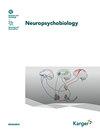Dysfunction of the Purinergic System in Bipolar Disorder
IF 3.1
4区 心理学
Q3 NEUROSCIENCES
引用次数: 0
Abstract
Objective: To verify the purinergic hypothesis of bipolar disorder (BD), we assessed the concentration of various components of the purinergic system in manic and depressed bipolar patients. Methods: Sixty-two patients (19 male and 43 female), aged 22–69 (49 ± 14) years, with BD were studied. Twenty-three patients (9 male and 14 female) were assessed during a manic episode and subsequent remission, and 39 patients (10 male and 29 female) were investigated in a depressive episode and the following remission. Twenty-two healthy subjects (8 male and 14 female), aged 19–70 (41 ± 14) years, served as the control group (CG). The severity of symptoms was evaluated using the Hamilton Depression Rating Scale (HDRS) and the Young Mania Rating Scale (YMRS). The concentrations of uric acid (UA) were estimated by the uricase-based method, whereas xanthine dehydrogenase (XDH), adenosine (Ado), and adenosine deaminase (ADA) by ELISA. Results: The mean score in the acute episode was 32 ± 8 points in the YMRS for mania and 31 ± 8 in the HDRS for depression. UA levels were significantly higher in female bipolar patients compared to the females in the CG. The concentrations of XDH, Ado, and ADA were significantly lower in bipolar patients both during an acute episode and remission compared to CG. Conclusions: A significant dysfunction of the purinergic system in patients with BD was observed. In most instances, the disturbances were not different in the acute episode than in remission what qualifies them as trait dependent. The results may confirm the role of the purinergic system in the pathogenesis of BD.双相情感障碍患者的嘌呤能系统功能障碍
目的:为了验证双相情感障碍(BD)的嘌呤能假说,我们评估了躁狂和抑郁双相患者嘌呤能系统的各种成分的浓度。方法:研究62例BD患者(男19例,女43例),年龄22-69岁(49±14)。23名患者(9名男性和14名女性)在躁狂发作和随后的缓解期间接受了评估,39名患者(10名男性和29名女性)接受了抑郁发作和随后缓解的调查。22名健康受试者(8名男性和14名女性),年龄19–70(41±14)岁,作为对照组(CG)。使用汉密尔顿抑郁量表(HDRS)和青年躁狂量表(YMRS)评估症状的严重程度。尿酸(UA)的浓度通过基于尿酸酶的方法估算,而黄嘌呤脱氢酶(XDH)、腺苷(Ado)和腺苷脱氨酶(ADA)的浓度则通过ELISA估算。结果:躁狂患者急性发作期YMRS的平均得分为32±8分,抑郁症患者HDRS的平均分为31±8分。女性双相情感障碍患者的UA水平明显高于对照组的女性。与CG相比,双相情感障碍患者在急性发作和缓解期间的XDH、Ado和ADA浓度均显著降低。结论:BD患者存在明显的嘌呤能系统功能障碍。在大多数情况下,急性发作期的障碍与缓解期的障碍没有什么不同,这使其成为特征依赖性障碍。这一结果可能证实嘌呤能系统在BD发病机制中的作用。
本文章由计算机程序翻译,如有差异,请以英文原文为准。
求助全文
约1分钟内获得全文
求助全文
来源期刊

Neuropsychobiology
医学-精神病学
CiteScore
7.20
自引率
0.00%
发文量
26
审稿时长
6 months
期刊介绍:
The biological approach to mental disorders continues to yield innovative findings of clinical importance, particularly if methodologies are combined. This journal collects high quality empirical studies from various experimental and clinical approaches in the fields of Biological Psychiatry, Biological Psychology and Neuropsychology. It features original, clinical and basic research in the fields of neurophysiology and functional imaging, neuropharmacology and neurochemistry, neuroendocrinology and neuroimmunology, genetics and their relationships with normal psychology and psychopathology. In addition, the reader will find studies on animal models of mental disorders and therapeutic interventions, and pharmacoelectroencephalographic studies. Regular reviews report new methodologic approaches, and selected case reports provide hints for future research. ''Neuropsychobiology'' is a complete record of strategies and methodologies employed to study the biological basis of mental functions including their interactions with psychological and social factors.
 求助内容:
求助内容: 应助结果提醒方式:
应助结果提醒方式:


